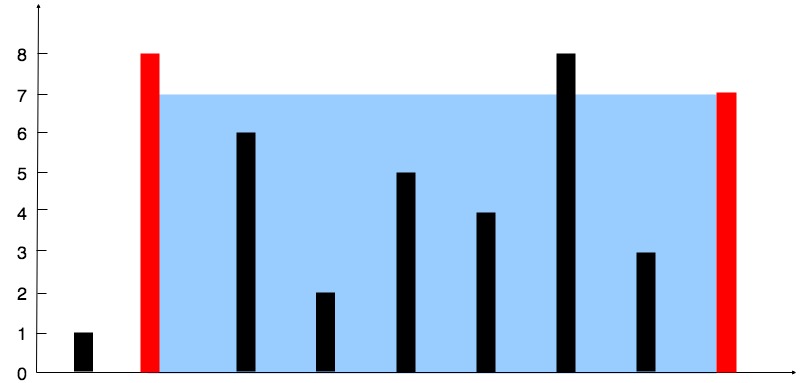1 2 3 4 5 6 7 8 9 10 11 12 13 14 15 16 17 18 19 20 21 22 23 24 25 26 27 28 29 30 31 32 33 34 35 36 37 38 39 40 41 42 43 44 45 46 47 48 49 50 51 52 53 54 55 56 57 58 59 60 61 62 63 64 65 66 67 68 69 70 71 72 73 74 75 76 77 78 79 80 81 82 83 84 85 86 87 88 89 90 91 92 93 94 95 96 97 98 99 100 101 102 103 104
//! # Description
//!
//! You are given an integer array height of length n. There are n vertical
//! lines drawn such that the two endpoints of the ith line are `(i, 0)` and
//! `(i, height[i])`.
//!
//! Find two lines that together with the x-axis form a container, such that
//! the container contains the most water.
//!
//! Return the maximum amount of water a container can store.
//!
//! Notice that you may not slant the container.
//!
//! Example 1:
//!
//! 
//!
//! ```plain
//! Input: height = [1,8,6,2,5,4,8,3,7]
//! Output: 49
//! Explanation: The above vertical lines are represented by array [1,8,6,2,5,4,8,3,7].
//! In this case, the max area of water (blue section) the container can contain is 49.
//! ```
//!
//! Example 2:
//!
//! ```plain
//! Input: height = [1,1]
//! Output: 1
//! ```
//!
//! Constraints:
//!
//! - `n == height.length`
//! - `2 $\leqslant$ n $\leqslant$ $10^5$`
//! - `0 $\leqslant$ height[i] $\leqslant$ $10^4$`
//!
//! Find out [this blog](https://dongs.xyz/post/algorithm-container-with-most-water/) about this problem (though it's in Chinese).
//!
//! Sources: <https://leetcode.com/problems/container-with-most-water/description/>
////////////////////////////////////////////////////////////////////////////////
/// Container With Most Water
///
/// # Arguments
/// * `height` - array of wall heights
pub fn max_area(height: Vec<i32>) -> i32 {
alg_1(height)
}
use core::cmp::max;
/// Traverse and find the the region which contains most water
///
/// # Arguments
/// * `height` - array of wall heights
fn alg_1(height: Vec<i32>) -> i32 {
let mut sidx: usize = 0;
let mut eidx = height.len() - 1;
let mut area_max = 0;
let area = |x: usize, y: usize| -> i32 {
return if height[x] >= height[y] {
height[y]
} else {
height[x]
} * (if x >= y { x - y } else { y - x }) as i32;
};
loop {
if sidx == eidx {
break;
}
area_max = max(area(sidx, eidx), area_max);
let mut moved = false;
if height[sidx] <= height[eidx] {
while sidx < eidx {
if height[sidx + 1] <= height[sidx] {
sidx += 1;
moved = true;
} else {
break;
}
}
if !moved {
sidx += 1;
}
} else {
while sidx < eidx {
if height[eidx - 1] <= height[eidx] {
eidx -= 1;
moved = true;
} else {
break;
}
}
if !moved {
eidx -= 1;
}
}
}
area_max
}